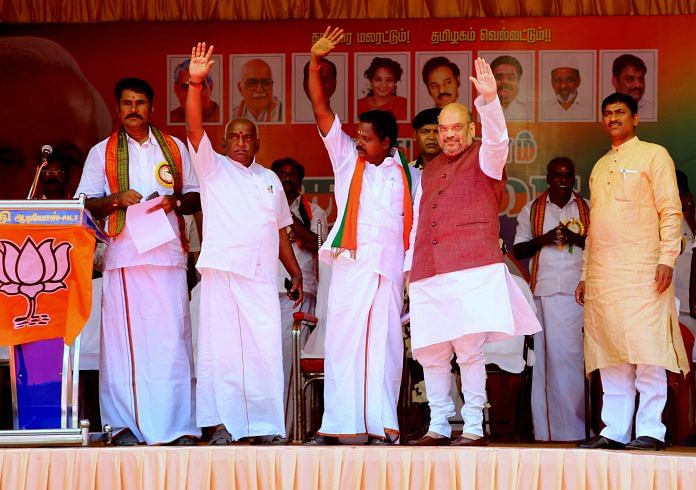The new face of Tamil Nadu’s regional politics visible during the Jallikattu protests and the Hindi imposition issue, may be a new offshoot of Dravidian ideology.
Viewed from Delhi, Tamil Nadu’s political culture appears as a hyper-local, complex maze of parties drenched in Dravidian ideology. In the past six decades, no one could rule in the state except one of the Dravida Kazhagams.
That political stalemate seems to be breaking now. What was once a political fortress that none of the national parties could breach today seems vulnerable: the squabbling in the ADMK after the demise of Jayalalitha, the prevailing instability in the government, a disregarded DMK trying unsuccessfully to project Stalin as the game-changer. There is no clear winner today, and both sides have lost popularity.
The void created by Jayalalitha’s exit has now opened the gates for others who have been trying hard to sneak into the state’s politics for long – this includes newcomers from within the state and outsiders. There is also some evidence that the BJP has been carefully shaping the internal feud in the ruling ADMK. In an already crowded arena of aspirers, Hindutva advocates are also fishing via their proxies.
Political satirist Cho Ramaswamy started this change two decades ago – in getting the BJP a toehold by bringing Atal Behari Vajpayee and Jayalalitha close. Now, his successor as editor of Tughlaq, S. Gurumurthy has taken it forward. As soon as Jayalalitha passed away, Gurumurthy had said he wouldn’t silently watch the spectre of Sasikala’s family taking over the ADMK.
The BJP’s first victories were in getting the state government to grudgingly comply with the center’s rollout of GST and NEET. Analysts have written that the shaky state of affairs and the absence of a strong leader like Jayalalitha made it easy. The centre’s use of the stick of IT raids and the carrot of helping the government continue also yielded results. Some ADMK leaders are busy working out private arrangements with the BJP politicians to secure political futures, rather than focusing on running the administration.
In recent years, both the Dravidian parties have undergone significant ideological dilution, deploying it only when electorally convenient. The flip-flop outcomes in the state is a symptom of who the voters hate more at any given time. Political analyst Sumanth Raman says: “Though the enthusiasm for the widespread Dravidian idea in the state is waning, there is not much zeal for Hindutva ideas either”.
The BJP appears to have cracked this riddle – it will keep its ideology down in the near-term, focus on projecting a combination of a local charismatic leadership, slogan of corrupt-free governance and ride ADMK’s voter base.
The wise men of BJP are too smart to rely only on ADMK. BJP is not unaware of the mistakes the Congress party made in Tamil Nadu. Once a dominant force in the state, the Congress did not build a mass leader of its own in the post-Kamaraj era. So, the BJP would probably also bring Rajini into the NDA-fold. The combination could devastate the rivals. “Among all the states of India, Tamil Nadu tops the cult of hero worship. The situation in Tamil Nadu is similar to the one in Andhra during NT Rama Rao’s entry,” says Ravindran Duraisamy, a Chennai-based political critic.
Like in Karnataka, party strategist Amit Shah is looking to carve out new pieces from the tested socio-political coalitions and break the existing architecture of social engineering that the Dravida parties have relied on. Shah is planning a series of meetings with the leaders of OBC groups who constitute 68% of the population in Tamil Nadu. He had earlier tried to constitute a new OBC-Dalit axis in the 2014 national election, when the NDA gained over 18 percent of the vote share.
Though these baby steps would help them grow, they can’t make it to Fort St. George on their own for a decade at least. But the BJP appears to be in a hurry to grab whatever they can from the Dravida parties without understanding that Tamil Nadu is not a state which can see a revolutionary change overnight. A keen observer of Tamil Nadu politics and a professor in University of Madras, Ramu Manivannan says: “Without sufficient groundwork BJP wants to come into power from the top, by accessing and influencing the political institutions,” that are already in place.
The growing Tamil nationalism among the youth visible during the Jallikattu protests and the Hindi imposition issue has become the new offshoot of Dravidian ideology. The absence of a strong face and a local leader is another impediment. People cannot be mobilised each time by just projecting Modi. But most importantly, the real challenge will be to see how the BJP’s nationalist identity reconciles with the strong Tamil sub-national linguistic and cultural pride.
Aananth Daksnamurthy is a business analyst at ThePrint, and follows Tamil Nadu politics closely.



